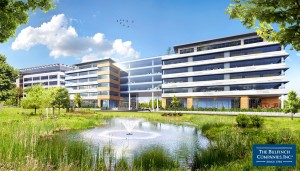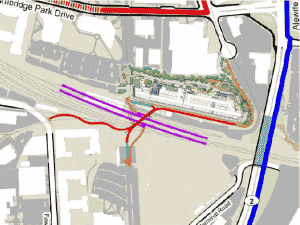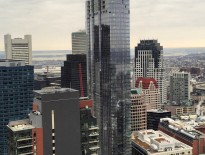
Bulfinch Cos. is marketing 250,000 square feet of build-to-suit office and lab space in the final phase of its Cambridge Discovery Park redevelopment in Alewife.
Alewife’s 2.5-million-square-foot commercial real estate cluster has been a traditional fallback for tech and life science companies seeking the prestige of a Cambridge address without the pain of Kendall Square rents.
Despite its transit-friendly location on the MBTA’s Red Line, Alewife has faced increasing competition from downtown Boston, which offers competitive rents in an urban environment that appeals to the tech crowd.
“At the end of the day, they’ll say, ‘It’s still Alewife.’ It still has a suburban feel to it,” said John Coakley, a vice president at brokerage Cresa Boston. “Do you want to work in the Seaport, or almost in Belmont?”
Upgrading transit and pedestrian access in the neighborhood is crucial to the future of West Cambridge. City officials are studying transportation upgrades, including a new commuter rail station on the Fitchburg line, with an eye toward selling air rights to developers. A pedestrian-bicycle bridge spanning the tracks would connect 130 acres of land known as the Quadrangle with the station, opening up redevelopment opportunities.
‘No Longer A Release Valve’
Ringed by large parking lots, Alewife’s suburban-style office and lab buildings have been among the last in Cambridge to fill up during real estate booms – and the first to empty out when the market tanks.
In previous generations, Alewife competed against Route 128’s office parks. In the current market, office users are just as likely to migrate toward Boston, with its competitive rents and better mix of transit stops.
“Cambridge tenants looking at Boston because of lack of space and pricing initially looked in the Seaport,” said Ted Lyon, executive managing director at Cushman & Wakefield. “Now they’re looking at class B product in the downtown and the lower half of the towers, because the pricing is significantly lower than doing an office deal in Kendall Square.”
Lab tenants have more limited options in Cambridge. There are 20 tenants looking for 1 million square feet of lab space in Cambridge, according to Colliers International. The current vacancy rate in Kendall Square is 0.1 percent, with a 3.1 percent availability rate, according to Cresa’s 2016 Market Insight Report.
New construction in Kendall is dominated by preleased buildings such as Bristol-Myers Squibb’s 250,000-square-foot complex at 100 Binney St., the 251,000-square-foot Sanofi Genzyme headquarters at 50 Binney St. and Bluebird Bio’s 253,000-square-foot complex at 60 Binney St.
Local developers such as Bulfinch Cos., King Street Properties and Davis Cos. are banking on Alewife’s growing appeal, viewing the neighborhood as a natural choice for large office and lab users shut out of East Cambridge.
“There’s always companies that are going to look at options because of pricing, but you’ve also got companies that really don’t want to leave Cambridge,” said Jonathan Davis, CEO of the Boston-based Davis Cos. “That’s the challenge for a lot of the non-pharma biotech companies, to make a decision about whether to stay in Cambridge is worth it.”
Davis Cos. acquired the 206,987-square-foot Fresh Pond Technology Center in 2012 for $38.4 million, when triple-net lab rents in the neighborhood were in the $25 to $30 range. Since then, they’ve risen to over $50 for prime locations, Davis said. Davis Cos. is planning upgrades to one 35,000-square-foot vacant building in the park later this year.
Eric Schlager, CEO of Needham-based Bulfinch Cos., says Alewife is prepared to stand on its own merits. He cited Cambridge-based King Street Properties’ successful repositioning of former Pfizer lab space at 200 Cambridgepark Drive. King Street spent $84 million to acquire and renovate the vacant 221,676-square-foot building in 2014 and sold it for $165.5 million in January after signing a roster of life science tenants including Celgene, Amgen, Unum Therapeutics and Enumeral Biomedical.

Cambridge officials have approved a transportation study of a pedestrian and bicycle bridge spanning the Fitchburg line commuter rail tracks and a commuter rail station in Alewife.
Bulfinch is negotiating with potential tenants for 250,000 square feet of build-to-suit office and lab space in the final phase of the 30-acre Cambridge Discovery Park property. Since acquiring the former Arthur D. Little headquarters in 2003, Bulfinch has demolished 15 buildings, built a new pedestrian path to Alewife station and attracted new anchor tenants in Forrester Research, Harvard Smithsonian Institution and Genocea Bioscences. Construction of a 150-room AC Hotel By Marriott is scheduled to be completed in early summer.
After adding amenities such as bike-sharing services, cafes and yoga studios, Bulfinch is promoting Cambridge Discovery Park as a city-style complex with rents up to 30 percent lower than Kendall Square.
“Alewife is no longer a release valve. It’s a thriving place to do business,” Schlager said.
Connecting The Quadrangle
Alewife Station was originally designed as part of a longer Red Line extension to Lexington. Today it serves 6 million riders a year, with commuters from the north and west filling the 2,700-space garage to capacity early each weekday.
Past attempts to authorize a commuter rail station on the nearby Fitchburg line were rejected by state officials because of insufficient population density in the area, said Iram Farooq, Cambridge’s assistant city manager for community development. The recent building boom, Farooq said, could prompt a second look.
In December, Cambridge officials authorized the next phase of a transportation study by HDR Inc. linking the north and south sides of the railroad tricks with a pedestrian and bicycle bridge. Developers of multifamily complexes at 88, 130 and 160 Cambridgepark Drive have agreed to provide space for possible “landing sites” for the walkway on the northern side, Farooq said. Massachusetts Department of Transportation officials, at a recent meeting with city officials, encouraged Cambridge to move forward with more detailed designs, Farooq said.
Whether to pursue the sale of air rights for development would be a state-level decision, since the MBTA owns the rail right-of-way.
“It would have to be very well-thought-out in terms of what the impact would be on at-grade development,” Farooq said. “When people developed on either side, they have not developed with air rights in mind.”
Davis sees opportunities for redevelopment of aging commercial properties on the southern side of the tracks if rent increases continue.
“We love our site because we bought it at a nice cap rate and we’re collecting rent, but if this continues, particularly if there’s a crossing constructed of the tracks, we think there exists a tremendous amount of upside,” he said. “It gives much more convenient access to public transportation.”




 |
| 

